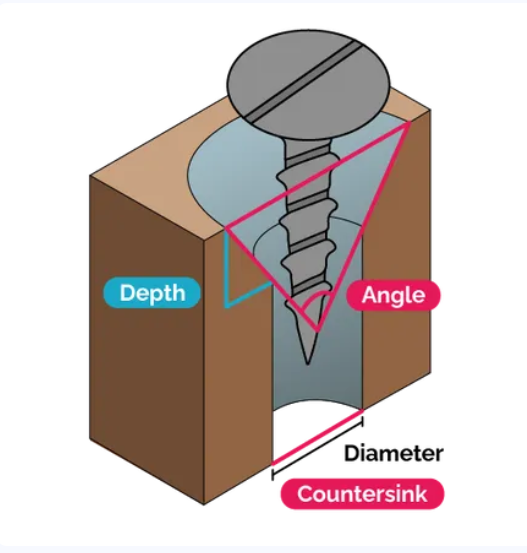1. What is Countersink Depth Calculator?
Definition: This calculator determines the depth of a countersink hole for a screw, given the diameter and angle of the countersink bit. It can also calculate the diameter or angle if the other two values are known.
Purpose: It helps woodworkers, metalworkers, and engineers ensure that screws sit flush with or below the surface of a material by calculating the precise depth of a countersink hole.
2. How Does the Calculator Work?
The calculator uses the following equations:
- Countersink Depth: \( \text{depth} = \frac{\text{diameter}/2}{\tan(\text{angle}/2)} \)
- Countersink Diameter: \( \text{diameter} = 2 \times \text{depth} \times \tan(\text{angle}/2) \)
- Countersink Angle: \( \text{angle} = 2 \times \arctan\left(\frac{\text{diameter}/2}{\text{depth}}\right) \)
Where:
- \( \text{depth} \): The depth of the countersink hole;
- \( \text{diameter} \): The diameter of the countersink at the surface;
- \( \text{angle} \): The angle of the countersink bit (in degrees).
Steps:
- Select what you want to calculate: countersink depth, diameter, or angle.
- Enter the required inputs (diameter, angle, or depth) and select their units.
- Click "Calculate" to compute the result.
- For length results (depth or diameter), change the unit using the dropdown to convert the result dynamically.
- Results are displayed with 4 decimal places or in scientific notation if less than 0.001.
3. Importance of Countersink Depth Calculation
Calculating countersink depth is crucial for:
- Precision: Ensures screws sit flush with or below the material surface.
- Safety: Prevents protruding screws that could cause injury or damage.
- Aesthetics: Creates a clean, professional finish in woodworking or metalworking projects.
4. Using the Calculator
Example 1: Calculate the countersink depth:
- Countersink Diameter: 10 mm;
- Countersink Angle: 90 degrees;
- Depth: \( \text{depth} = \frac{10/2}{\tan(90^\circ/2)} = \frac{5}{\tan(45^\circ)} = 5 \, \text{mm} \);
- Result: Countersink Depth = 5.0000 mm (can be converted to 0.1969 in).
Example 2: Calculate the countersink diameter:
- Countersink Depth: 5 mm;
- Countersink Angle: 90 degrees;
- Diameter: \( \text{diameter} = 2 \times 5 \times \tan(90^\circ/2) = 2 \times 5 \times 1 = 10 \, \text{mm} \);
- Result: Countersink Diameter = 10.0000 mm (can be converted to 0.3937 in).
Example 3: Calculate the countersink angle with different units:
- Countersink Diameter: 0.5 in (12.7 mm);
- Countersink Depth: 0.25 in (6.35 mm);
- Angle: \( \text{angle} = 2 \times \arctan\left(\frac{12.7/2}{6.35}\right) = 2 \times \arctan(1) = 2 \times 45^\circ = 90^\circ \);
- Result: Countersink Angle = 90.0000 degrees.
5. Frequently Asked Questions (FAQ)
Q: What is a countersink?
A: A countersink is a conical hole cut into a material to allow the head of a screw to sit flush with or below the surface.
Q: What are common countersink angles?
A: Common countersink angles are 60°, 82°, 90°, 100°, 110°, and 120°, depending on the type of screw and material.
Q: Why is countersink depth important?
A: Proper countersink depth ensures that screws are flush, improving the appearance and safety of the finished product.
Countersink Depth Calculator© - All Rights Reserved 2025
 Home
Home
 Back
Back
